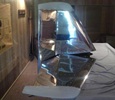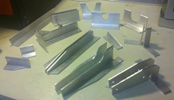


random user submitted photo
Sonex strength
6 posts
• Page 1 of 1
Sonex strength
I had the opportunity to test the strength of my Sonex recently so thought I'd give all you builders and flyers a warm fuzzy feeling. I was flying with a friend at close to MAUW on a warm day. The sun had been heating the ground up but cloud had moved in forcing us down to about 2000 ft AGL, so we were bumping along copping both turbulence from the clouds as well as thermals off the ground. Speed was backed off to under 110 knots when we passed over a pine plantation, much darker than the surrounding country, and hit a "rock". There was quite a loud thump and we were thrown up against the seat belts, head-sets dislodged and ipad hit the canopy followed by relative calm and an uneventful landing, although I was pretty careful to avoid other pine plantations. Maximum recorded on the G-meter was +6.9, -0.5. I don't recall ever seeing higher than 3g on it before.
Kerry Fores suggested the following check list:
• Spars and wing skins for permanent deformation.
• Tail surfaces, for deformation and security.
• Control hinges for security and cracks.
• Seat support structure and hinges.
• All structure for loose rivets.
• Engine mount for deformation or cracks
• Fuel tank support strap integrity
• Deformation of the upper longerons where the fuel tank support straps are attached.
I also checked the top longeron splice and tailplane attachment to longerons using a USB microscope and did a dye-penetrant check of the fuselage attachments to the engine mount and the result was:
No visible damage - I was pretty happy about that.
A couple of related points:
• My Sonex has aluminium tank straps - not the later type steel ones.
• All the rivets I used to attach piano hinge to the seat pan are 3/32 solids, which proved to be easily strong enough.
• My engine mount is in my opinion considerably stronger than the stock Sonex mount.

The incident has given me plenty of confidence in the Sonex design.
Peter
Sonex 894 237 hours
Kerry Fores suggested the following check list:
• Spars and wing skins for permanent deformation.
• Tail surfaces, for deformation and security.
• Control hinges for security and cracks.
• Seat support structure and hinges.
• All structure for loose rivets.
• Engine mount for deformation or cracks
• Fuel tank support strap integrity
• Deformation of the upper longerons where the fuel tank support straps are attached.
I also checked the top longeron splice and tailplane attachment to longerons using a USB microscope and did a dye-penetrant check of the fuselage attachments to the engine mount and the result was:
No visible damage - I was pretty happy about that.
A couple of related points:
• My Sonex has aluminium tank straps - not the later type steel ones.
• All the rivets I used to attach piano hinge to the seat pan are 3/32 solids, which proved to be easily strong enough.
• My engine mount is in my opinion considerably stronger than the stock Sonex mount.
The incident has given me plenty of confidence in the Sonex design.
Peter
Sonex 894 237 hours
- peter anson
- Posts: 546
- Joined: Thu Jul 31, 2014 2:34 am
- Location: Mount Macedon, Australia
Re: Sonex strength
I had a private message about the circumstances of the "wall" I ran into but have not been able to send a response so I assume their settings don't allow it. I'll answer here:
I had not come across such a violent thermal before but the friend I was flying with, who lives in that area didn't seem too surprised. Pine trees are not native to Australia so this was a plantation. It was much darker than the surrounding country so I assume formed a more effective collector and emitter of radiant energy. The trees being much higher and denser than the adjacent grassland would also be more effective heating up the air. Flying anywhere in Australia in summer is pretty rough. I try to avoid flying after about 10AM and have had to go to above 7000 ft to get above thermals even in spring. I'm told that in central Australia the ground thermals go up to 14000 ft. I'm sure there are plenty of parts of the US that experience similar conditions. I think that the problem I encountered may have been due to the large difference between the grassland and plantation. I have done a couple of trips along the coast and always fly over the water because it's so much smoother.
Peter
I had not come across such a violent thermal before but the friend I was flying with, who lives in that area didn't seem too surprised. Pine trees are not native to Australia so this was a plantation. It was much darker than the surrounding country so I assume formed a more effective collector and emitter of radiant energy. The trees being much higher and denser than the adjacent grassland would also be more effective heating up the air. Flying anywhere in Australia in summer is pretty rough. I try to avoid flying after about 10AM and have had to go to above 7000 ft to get above thermals even in spring. I'm told that in central Australia the ground thermals go up to 14000 ft. I'm sure there are plenty of parts of the US that experience similar conditions. I think that the problem I encountered may have been due to the large difference between the grassland and plantation. I have done a couple of trips along the coast and always fly over the water because it's so much smoother.
Peter
- peter anson
- Posts: 546
- Joined: Thu Jul 31, 2014 2:34 am
- Location: Mount Macedon, Australia
Re: Sonex strength
I notice that some of your engine mount is square tube and some is round. Is there an advantage to square? Is it stronger? When would you use square vs round? Just curious.
George
George
George Mueller
Onex Trigear
Rotax 912 ULS
Onex Trigear
Rotax 912 ULS
- gcm52
- Posts: 88
- Joined: Wed Feb 04, 2015 12:23 pm
Re: Sonex strength
I have hit such clear air turbulence. My Enigma only recorded the positive 6.5 g, but after the positive g load came a serious negative g load that pinned everything (including me) in the cockpit to the canopy for a solid second. No signs of damage either. However, it emptied my small cooler full of ice and drinks, a bag of potato chips, and scattered various other things (phone, Spot, etc) all over the place. This happened over eastern Colorado, more than 100 miles from the Mountain range. I was at 8000 ft altitude, and cruising at ~150 mph TAS. Most violent thing I have ever experienced in my Sonex. I personally thanked John Monnett for the durable design.
-

rbarber - Posts: 103
- Joined: Sat Mar 10, 2012 5:47 pm
Re: Sonex strength
rbarber wrote:I have hit such clear air turbulence. My Enigma only recorded the positive 6.5 g, but after the positive g load came a serious negative g load that pinned everything (including me) in the cockpit to the canopy for a solid second.
Mountain turbulence shouldn't be taken lightly; though we glider pilots really like the lift that often accompanies it... :-)
https://www.youtube.com/watch?v=DYJufTZg3pQ
(Pay attention to the instrument in the center-right of the panel. That's the variometer - essentially a sensitive VSI. Count how many times it pegs at over 1000 fpm - up or down - in this video)
--Noel
[who also appreciates the sturdy Sonex airframe]
- NWade
- Posts: 527
- Joined: Mon Aug 08, 2011 3:58 pm
Re: Sonex strength
I notice that some of your engine mount is square tube and some is round. Is there an advantage to square? Is it stronger? When would you use square vs round? Just curious.
I happened to have some square tube available and it made some of the cuts easier when I was building the mount. Other than that there's not much advantage in using the square tube the way I have used it because in a true space frame all the loads are either tension or compression. The weight of the engine acts a bit forward of where the tubes join so in practice there is a small bending moment on the tube. For bending loads, the square tube should effectively be about 70% stronger (but 27% heavier) so I guess there is a small advantage.
The top part of the engine mount is pretty close to the stock Sonex 3300 mount except for the cross beam. I couldn't buy the correct size tube in Australia so ended up making that from a larger size commercial section.
I did a few very rough back of the envelope type calculations for a some of the parts I didn't check and they made me pretty confident that there is no other damage. Nice to hear of another Sonex to experience similar loads without damage.
Peter
- peter anson
- Posts: 546
- Joined: Thu Jul 31, 2014 2:34 am
- Location: Mount Macedon, Australia
6 posts
• Page 1 of 1
Who is online
Users browsing this forum: No registered users and 28 guests







